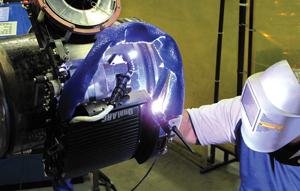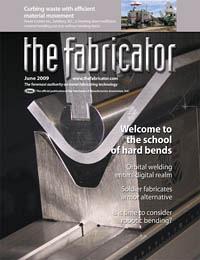Marketing Communications Director
- FMA
- The Fabricator
- FABTECH
- Canadian Metalworking
Categories
- Additive Manufacturing
- Aluminum Welding
- Arc Welding
- Assembly and Joining
- Automation and Robotics
- Bending and Forming
- Consumables
- Cutting and Weld Prep
- Electric Vehicles
- En Español
- Finishing
- Hydroforming
- Laser Cutting
- Laser Welding
- Machining
- Manufacturing Software
- Materials Handling
- Metals/Materials
- Oxyfuel Cutting
- Plasma Cutting
- Power Tools
- Punching and Other Holemaking
- Roll Forming
- Safety
- Sawing
- Shearing
- Shop Management
- Testing and Measuring
- Tube and Pipe Fabrication
- Tube and Pipe Production
- Waterjet Cutting
Industry Directory
Webcasts
Podcasts
FAB 40
Advertise
Subscribe
Account Login
Search
Orbital welding technology breaks new ground
- By Bill Atkinson
- June 4, 2009
- Article
- Tube and Pipe Fabrication
Automated orbital welding has been a driving force in industry since its introduction in the 1960s. From the aerospace industry—where orbital welding began—to the food, dairy, and beverage industries, offshore petroleum, pharmaceutical, semiconductor production, and the power utility sector, orbital welding has become an integral process for manufacturing and maintenance. Automated systems have been devised for the orbital welding of ultrahigh-purity tubing, heavy-walled pipes, aircraft components, and large tanks and vessels.
Initially simple systems controlled the welding arc by maintaining speed, voltage, and amperage. Upslope and downslope control was provided, as well as lateral oscillation to fill the void in the joint profile.
With increasing computer control through weld sequence programmability, it was just a matter of time before digital controllers addressed more and more parameters of the weld. Today the welding controller can retain a range of tested and certified presets stored into memory. The weld controllers of today give the operator control over time, duration, and electrical characteristics of the arc, ensuring uniform penetration, control over the critical root pass, and optimal side-wall fusion. Accurate weld prep geometry and precision arc control help minimize heat-affected zones (HAZs). Smaller and faster computing technology has enabled more capabilities, including portable precision measuring systems and remote control of beveling and welding processes for applications in confined or hazardous environments.
Until recently orbital welding technology focused primarily on producing superior weld preparation and more intelligent, intuitive weld controllers. As the field of orbital welding has matured, welders increased their knowledge about the fusion characteristics of exotic alloys and proven methodologies learned through hands-on orbital welding experience.
Emerging technology, however, undoubtedly will change the orbital welding landscape.
Intelligence and Flexibility
Work force shortages mandate that new welding equipment provides more intelligent control. Increasingly, the legacy knowledge gained about orbital welding will need to be built into the equipment through pre-established weld programs as well as circuitry that performs intelligent monitoring of the weld arc itself. Systems that can sense the operational variables "through" the active arc can modify their behavior in real time to adjust and adapt to the mechanical geometry of the weld joint and the integrity of the weld puddle.
Orbital welding controllers are entering the marketplace with a range of capabilities that focus on being able to read and recognize the inevitable idiosyncrasies of an individual weld situation.
Advanced weld logic controllers now can provide automatic steering of the weld head through a unique procedure in which the welder plots physical reference points around the weld joint before the actual welding process. This modifies the program and steers the head properly during the weld operation, whether there are regular or irregular welding surfaces or planes associated with the joint.
New controllers also increase versatility, offering both gas tungsten arc and gas metal arc welding (GTAW and GMAW) in one unit. Some industries historically have resisted using GMAW, and it was not until the inclusion of the flux-cored capability that some traditionally non-GMAW industries would consider using machine-welding systems for extremely high-pressure applications.
While some industries may be slow to adopt multiple-process equipment, the overriding benefits of having multiple capabilities in one machine may make these new, more flexible systems desirable for companies trying to cut costs. Operators now can have a power source, weld control console, cooler, and remote pendant for cold-wire GTAW, hot-wire GTAW, short-circuit and pulsed-spray transfer GMAW (GMAW-S and GMAW-P), and flux-cored arc welding (FCAW) in a single, coordinated system. The operator can switch quickly from one process mode to another, and if he forgets to switch polarity when changing between GTAW and GMAW, for example, the system can remind him to do so.
Better Safety
Operator safety has factored into orbital welding technology development. Stringent new OSHA requirements for the monitoring and control of hexavalent chrome fumes have made necessary operation of welding equipment in full face masks, imposing significant difficulties for the welder. While not exactly "set and forget," orbital weld controllers do permit the operator to monitor and perform the welding process at a distance. This is important as the issue of exposure to welding gases may exacerbate the critical welder shortage, because fatigue and fume concerns require more welders on staff. Safety and environmental concerns also have spurred demand for sophisticated power supply circuitry that moderates the short-circuit waveform to reduce smoke and spatter up to 85 percent.
Going Digital
Orbital welding systems have been controlled by either analog or digital control. Fully digital systems provide many inherent advantages, including ease of use and time savings. Degree-based digital systems divide a single orbit of the weld head into encoded segments that permit the controller to calculate distance as a program parameter and allow the same weld head to adapt for use with noncircular or flat weld joints. Such controllers also are scalable; for instance, a sequence designed for a 6-inch weld now can be applied to a 12-in.-diameter without reprogramming.
These controllers allow the operator to search and select from a library of default programs that are factory-preloaded into the control console. The control uses a search engine where variables such as pipe diameter, material, bevel and gas type, and wire diameter can be entered, and the system will generate suggested weld programs for optimal results. Programs can be generated on remote PCs, e-mailed, and transferred to the controller via a USB dongle. Features can be locked out (or made invisible) on the console to limit the number of selectable items. Weld programs can also be password-protected and are intuitive enough to permit predetermined parameter "bracketing," which limits the operational variation to previously tested and proven limits.
Operators also can edit the weld program during the program execution. This means that the operator can modify upcoming program instruction lines before their execution without stopping the running program. Program instructions now offer an essentially infinite number of weld parameter changes during a single revolution. Instead of being limited to a set number of changes, programs permit a parameter change in increments as minute as 1/10 of 1 degree, or 1/10 in. of weld head travel (in distance mode).
Digital technology allows automatic torch proximity control without close monitoring by the operator. For GMAW and FCAW, automatic torch height control frees the operator to perform other actions without experiencing loss of shielding gas and the resulting porosity problems.
A Control That Learns
Controllers now can perform real-time data logging that monitors and "learns" user inputs to fine-tune a program for a specific weld situation. While one operator is performing a weld operation, another operator can be loading and setting up the next weld. Program lines can run sequentially, and end lines of code can trigger the next programmed sequence so a complete weld can run from root pass to finished cap as a single operation. Weld caps can be programmed for consistent increments so that the deposition of the final beads leaves a minimum of weld surfacing for pre- and in-service inspections (PSI and ISI).
Welding a New Path
Traditionally, computer controlled orbital welding machines have demanded that the joint conform to geometric expectations to attain reliable, satisfactory results. But in certain applications and industries, the technology of recent years that has focused on providing more accurate weld preparation may be less of a factor. Real-time evaluation, processing, and modification of the welding arc will allow systems to adapt for inconsistencies that arise in joint configurations. What this means is that automated open-root-pass welding on standard, off-the-shelf 30- or 37-degree bevels, previously achievable only with GMAW systems, is now reliably done with GTAW machines.
While this does not mean that precision weld preparation is no longer an important requirement for most welds, it does mean that orbital welding systems will be able to adapt appropriately to deliver predictable, repeatable results on less-than-optimal weld joint geometry, providing significant cost and time savings.
In a practical sense, orbital welding controllers have gone through another major change, with new, user-friendly equipment being designed with off-the-shelf components whenever possible to ease maintenance and reduce system downtime. Orbital control systems that weighed as much as 900 pounds in the past are now portable enough to be carried by two people or be transported by hand truck to wherever needed on the job site.
Finally, the versatility and programmability of multimode weld controllers mean that the same system can multitask for orbital welding, plate welding, boiler tube welding, tube-to-tube sheet welds, and for welding large-diameter vessels when configured with corresponding track mounting.
While some of this technology isn't yet available in retail products for industry, it has already been introduced and is currently being implemented by contract and field machining service projects, and it will be available in products soon. Companies also can access these new control systems under field-testing and certification programs.
The reality is that fewer experienced welders are available. To help meet industry demands, manufacturers have developed machinery that allows a new generation of operators to produce the quality and repeatable welds so crucial to so many industries.
About the Author
Bill Atkinson
3041 Sunrise Blvd.
Rancho Cardova, CA 95742
800-345-5015
Related Companies
subscribe now

The Fabricator is North America's leading magazine for the metal forming and fabricating industry. The magazine delivers the news, technical articles, and case histories that enable fabricators to do their jobs more efficiently. The Fabricator has served the industry since 1970.
start your free subscription- Stay connected from anywhere

Easily access valuable industry resources now with full access to the digital edition of The Fabricator.

Easily access valuable industry resources now with full access to the digital edition of The Welder.

Easily access valuable industry resources now with full access to the digital edition of The Tube and Pipe Journal.
- Podcasting
- Podcast:
- The Fabricator Podcast
- Published:
- 04/16/2024
- Running Time:
- 63:29
In this episode of The Fabricator Podcast, Caleb Chamberlain, co-founder and CEO of OSH Cut, discusses his company’s...
- Trending Articles
AI, machine learning, and the future of metal fabrication

Employee ownership: The best way to ensure engagement

Steel industry reacts to Nucor’s new weekly published HRC price

Dynamic Metal blossoms with each passing year

Metal fabrication management: A guide for new supervisors

- Industry Events
16th Annual Safety Conference
- April 30 - May 1, 2024
- Elgin,
Pipe and Tube Conference
- May 21 - 22, 2024
- Omaha, NE
World-Class Roll Forming Workshop
- June 5 - 6, 2024
- Louisville, KY
Advanced Laser Application Workshop
- June 25 - 27, 2024
- Novi, MI



























